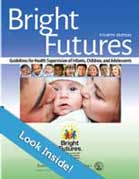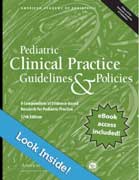Clinical Guidelines for Care of Children with Medical Complexity
Health supervision and clinical practice guidelines typically are developed and/or adopted by national organizations, such as the American Academy of Pediatrics (AAP), expert working groups, or other knowledgeable bodies. These organizations periodically review and update the guidelines or decide to stop using them if they are no longer the standard of care (or if resources are lacking to update them).

 5.1 MB).
5.1 MB).

Clinical Guidelines for Children & Adolescents with Complex Medical Needs
AAP-endorsed practice guidelines can assist primary care providers in caring for children with special health care needs. Some of these are cross-cutting, looking at practice models to implement team-based care and patient- and family-centered medical home models; others are specific to a certain medical or genetic condition. The Medical Home Portal provides information about these models of care at:
The following are particularly relevant to the overall care of the child or adolescent with special health care needs:
-
Pordes E, Gordon J, Sanders LM, Cohen E.
Models of Care Delivery for Children With Medical Complexity.
Pediatrics. 2018;141(Suppl 3):S212-S223. PubMed abstract -
Council on Children with Disabilities and Medical Home Implementation Project Advisory Committee.
Patient- and family-centered care coordination: a framework for integrating care for children and youth across multiple systems.
Pediatrics. 2014;133(5):e1451-60. PubMed abstract -
American Academy of Pediatrics Council on Children with Disabilities.
A consensus statement on health care transitions for young adults with special health care needs.
Pediatrics. 2002;110(6 Pt 2):1304-6. PubMed abstract / Full Text -
Kuo DZ, Houtrow AJ.
Recognition and Management of Medical Complexity.
Pediatrics. 2016;138(6). PubMed abstract / Full Text -
Adams RC, Tapia C.
Early intervention, IDEA Part C services, and the medical home: collaboration for best practice and best outcomes.
Pediatrics. 2013;132(4):e1073-88. PubMed abstract / Full Text -
Murphy NA, Carbone PS.
Parent-provider-community partnerships: optimizing outcomes for children with disabilities.
Pediatrics. 2011;128(4):795-802. PubMed abstract / Full Text -
Elias ER, Murphy NA.
Home care of children and youth with complex health care needs and technology dependencies.
Pediatrics. 2012;129(5):996-1005. PubMed abstract / Full Text -
Friedman SL, Kalichman MA.
Out-of-home placement for children and adolescents with disabilities.
Pediatrics. 2014;134(4):836-46. PubMed abstract -
Friedman SL, Norwood KW Jr.
Out-of-Home Placement for Children and Adolescents With Disabilities-Addendum: Care Options for Children and Adolescents With Disabilities and Medical Complexity.
Pediatrics. 2016;138(6). PubMed abstract -
Percelay JM.
Physicians' roles in coordinating care of hospitalized children.
Pediatrics. 2003;111(3):707-9. PubMed abstract -
Committee on Hospital Care.
Pediatric Palliative Care and Hospice Care Commitments, Guidelines, and Recommendations.
Pediatrics. 2013;132(5):966-972. PubMed abstract / Full Text -
Linebarger JS, Johnson V, Boss RD, Linebarger JS, Collura CA, Humphrey LM, Miller EG, Williams CSP, Rholl E, Ajayi T, Lord B, McCarty CL.
Guidance for Pediatric End-of-Life Care.
Pediatrics. 2022;149(5). PubMed abstract -
National Coalition for Hospice and Palliative Care.
Clinical practice guidelines for quality palliative care, 4th ed.
2018; Richmond, VA https://www.nationalcoalitionhpc.org/ncp/
Clinical practice guidelines to formalize and delineate the provisions of high-quality community-based palliative care for adults, children, and families living with serious, chronic illness; endorsed the American Academy of Pediatrics.
Guidelines for specific conditions can be found at Diagnoses & Conditions by selecting a condition name from the list and scrolling to the Practice Guidelines section of the module.
Resources
Information & Support
Related Portal Content
For Professionals
American Academy of Pediatrics Publications Search for Guidelines and Policies (AAP)
A search engine to identify clinical practice guidelines, health supervision guidelines, clinical reports, and other policies
published or endorsed by the AAP.
Council on Children with Disabilities Policies & Reports (AAP)
A list of policies pertaining to the care of children with disabilities; American Academy of Pediatrics.
American Academy of Child and Adolescent Psychiatry Practice Parameters (AACAP)
Clinical practice guidelines for child mental health, which include topics such as obsessive-compulsive disorder, use of psychotropic
medications, and gay, lesbian, bisexual, and transgender youth issues.
American College of Medical Genetics and Genomics Practice Guidelines (ACMG)
Screening and genetic testing guidelines and algorithms for a variety of genetic conditions.
American Academy of Neurology Child Neurology Practice Guidelines (AAN)
A compilation of practice guidelines for a variety of congenital and acquired neurological conditions affecting children,
including headaches, epilepsy, concussion, cerebral palsy, global developmental delay, and sudden hearing loss.
Pediatric Clinical Practice Guidelines & Policies, 22nd Edition (AAP)
Published in 2022, this book includes practice guidelines for many diagnoses ranging from autism spectrum disorder to urinary
tract infections. It also contains policies ranging from addressing early childhood emotional and behavioral problems to preventing
obesity. The 22nd edition was published in 2022 and is endorsed by the American Academy of Pediatrics.
Bright Futures Guidelines for Health Supervision - Pocket Guide, 4th Edition (AAP) ( 5.1 MB)
5.1 MB)
A uniform set of recommendations for health care professionals that highlights 12 child health topics and contains an abbreviated
version for healthy child visits; American Academy of Pediatrics.
Authors & Reviewers
| Author: | Claire K Turscak, MD, MS |
| Reviewer: | Jennifer Goldman, MD, MRP, FAAP |
| 2017: update: Jennifer Goldman, MD, MRP, FAAPA |
| 2013: first version: Chuck Norlin, MDA |
Page Bibliography
Adams RC, Tapia C.
Early intervention, IDEA Part C services, and the medical home: collaboration for best practice and best outcomes.
Pediatrics.
2013;132(4):e1073-88.
PubMed abstract / Full Text
Published in 2013 and reaffirmed in August 2017, this clinical report provides information for primary care providers about
early intervention services and optimal partnership and referrals.
American Academy of Pediatrics Council on Children with Disabilities.
A consensus statement on health care transitions for young adults with special health care needs.
Pediatrics.
2002;110(6 Pt 2):1304-6.
PubMed abstract / Full Text
A policy statement providing guidance on how to seamlessly transition services for young adults to adult health care providers
to best optimize function for the individual with special health care needs.
Committee on Hospital Care.
Pediatric Palliative Care and Hospice Care Commitments, Guidelines, and Recommendations.
Pediatrics.
2013;132(5):966-972.
PubMed abstract / Full Text
AAP policy for pediatric palliative and hospice care with guidance for primary care clinicians about end of life care.
Council on Children with Disabilities and Medical Home Implementation Project Advisory Committee.
Patient- and family-centered care coordination: a framework for integrating care for children and youth across multiple systems.
Pediatrics.
2014;133(5):e1451-60.
PubMed abstract
Elias ER, Murphy NA.
Home care of children and youth with complex health care needs and technology dependencies.
Pediatrics.
2012;129(5):996-1005.
PubMed abstract / Full Text
An AAP clinical report, reaffirmed in 2017, which discusses topics for families and providers to consider when transitioning
a child from the hospital to home.
Friedman SL, Kalichman MA.
Out-of-home placement for children and adolescents with disabilities.
Pediatrics.
2014;134(4):836-46.
PubMed abstract
Friedman SL, Norwood KW Jr.
Out-of-Home Placement for Children and Adolescents With Disabilities-Addendum: Care Options for Children and Adolescents With
Disabilities and Medical Complexity.
Pediatrics.
2016;138(6).
PubMed abstract
Kuo DZ, Houtrow AJ.
Recognition and Management of Medical Complexity.
Pediatrics.
2016;138(6).
PubMed abstract / Full Text
A clinical report that provides guidance for primary care clinicians to optimize care and decrease utilization costs for children
with special health care needs.
Linebarger JS, Johnson V, Boss RD, Linebarger JS, Collura CA, Humphrey LM, Miller EG, Williams CSP, Rholl E, Ajayi T, Lord
B, McCarty CL.
Guidance for Pediatric End-of-Life Care.
Pediatrics.
2022;149(5).
PubMed abstract
Murphy NA, Carbone PS.
Parent-provider-community partnerships: optimizing outcomes for children with disabilities.
Pediatrics.
2011;128(4):795-802.
PubMed abstract / Full Text
Published in October 2011 and reaffirmed in August 2017, this clinical report details the policy regarding optimal partnership
among the primary care medical home, the family, and communities to address the mufti-faceted needs of children with chronic
and complex conditions.
National Coalition for Hospice and Palliative Care.
Clinical practice guidelines for quality palliative care, 4th ed.
2018; Richmond, VA https://www.nationalcoalitionhpc.org/ncp/
Clinical practice guidelines to formalize and delineate the provisions of high-quality community-based palliative care for
adults, children, and families living with serious, chronic illness; endorsed the American Academy of Pediatrics.
Percelay JM.
Physicians' roles in coordinating care of hospitalized children.
Pediatrics.
2003;111(3):707-9.
PubMed abstract
Revised in 2010 and reaffirmed in August 2017, this clinical report details the policy regarding optimal partnership among
the primary care medical home and subspecialists involved in inpatient care of a sick child.
Pordes E, Gordon J, Sanders LM, Cohen E.
Models of Care Delivery for Children With Medical Complexity.
Pediatrics.
2018;141(Suppl 3):S212-S223.
PubMed abstract


 Get More Help in Nevada
Get More Help in Nevada